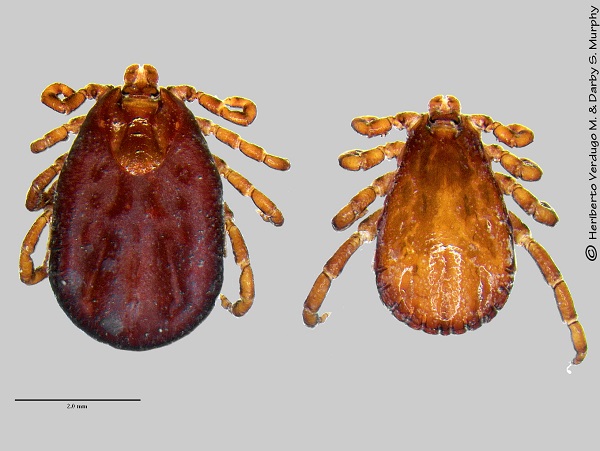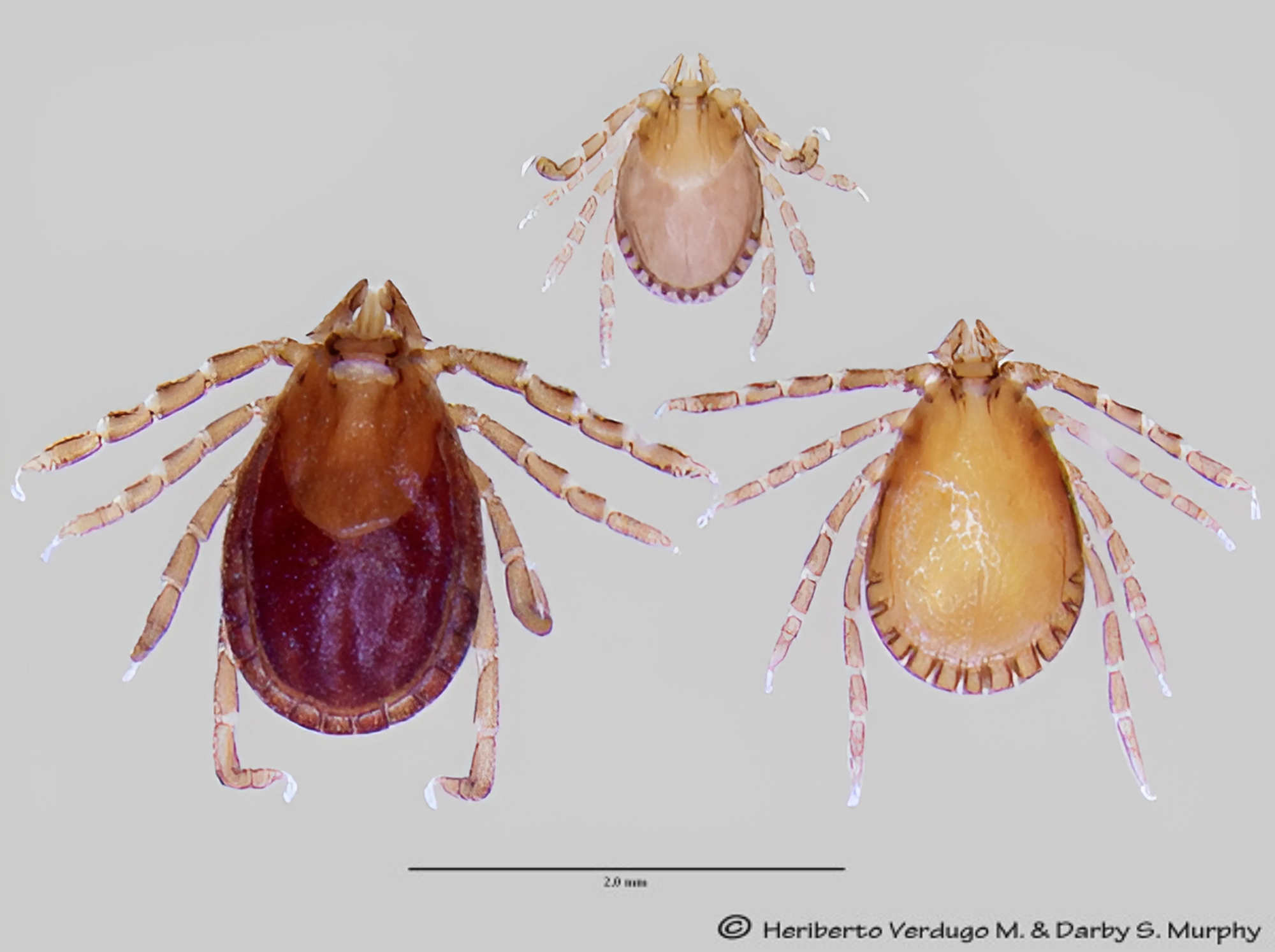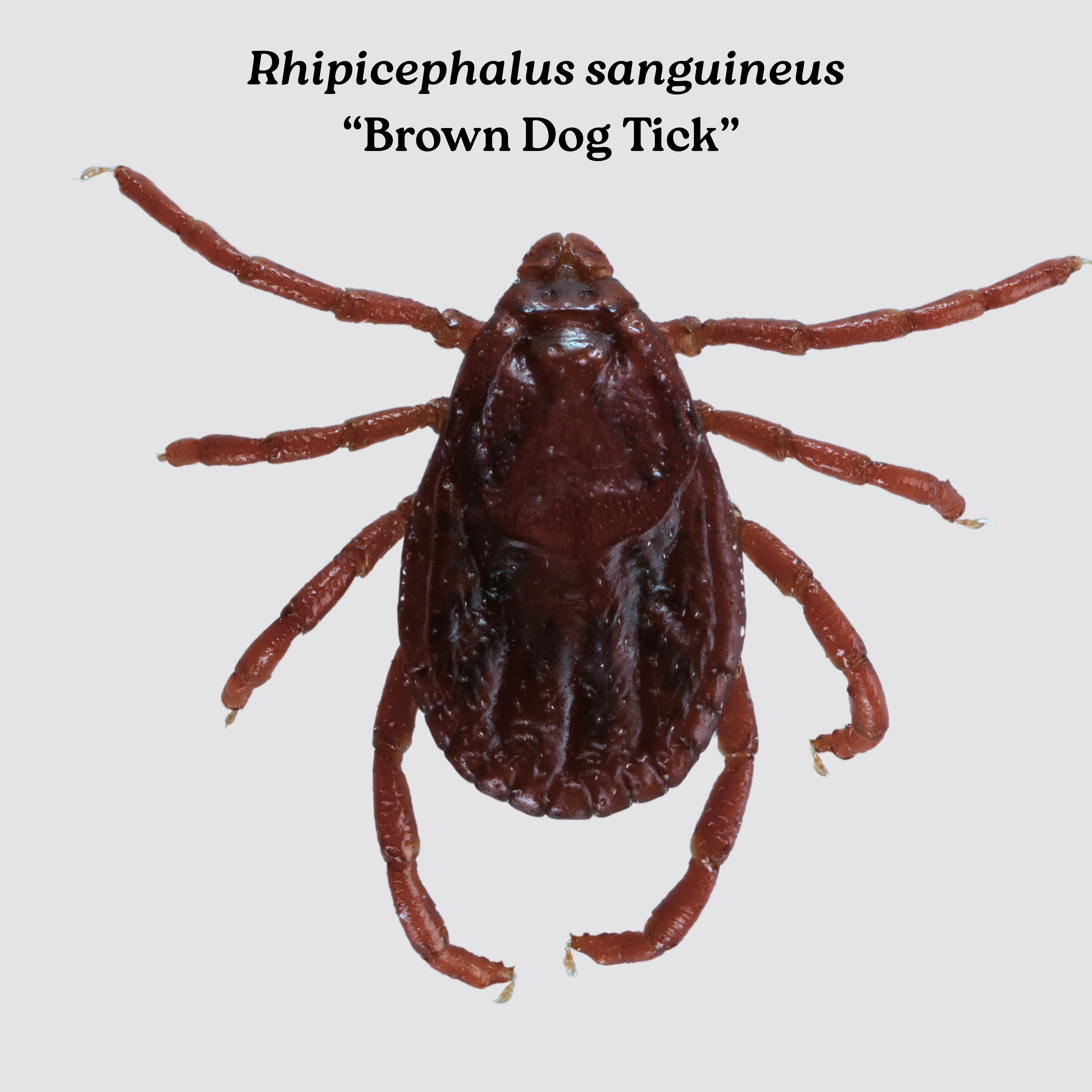Not yet Established in Wisconsin but Ticks of Medical/Veterinary Concern:
- The Asian Longhorned Tick
- The Lone Star Tick
This is an accordion element with a series of buttons that open and close related content panels.
Dermacentor albipictus

Scientific Name: Dermacentor albipictus
Common Name: Winter Tick
Host/Life Cycle: This tick is a one-host tick, which means that a tick spends all three active life stages (larvae, nymph, adult) on the same host. This tick commonly chooses moose, elk, and deer for a host and is most commonly associated with moose populations.
Geographic Range in Wisconsin: This tick is not common in Wisconsin. In a passive surveillance study from 2011-2017, the Surveillance of Wisconsin Animals for Ticks (SWAT) program identified 1.7% of the 10,136 tick specimens as D. albipictus. All of these ticks came from a farmed elk/white tailed deer operation.
Medical/Veterinary Importance: This tick is considered a potential threat to wildlife, specifically moose populations in other states. Moose sightings are uncommon in Wisconsin.
Haemaphysalis leporispalustris (The Rabbit Tick)
 Scientific Name: Haemaphysalis leporispalustris
Scientific Name: Haemaphysalis leporispalustris
Common Name: Rabbit tick
Host: The Rabbit tick is a three-host tick, meaning it feeds on three different hosts during each active life stage. Adults feed primarily on rabbits and are often found on or around the ears. Rabbit ticks typically do not feed on humans.
Geographic Range in Wisconsin: Of the ticks collected through our Surveillance of Wisconsin Animals for Ticks (SWAT) program from 2011-2017, 13.8% of ticks found on animals were H. leporispalustris.
Ixodes angustus
Scientific Name: Ixodes angustus
Common Name: None
Host/Life Cycle: This tick species has a wide range of hosts, mainly insectivores and rodents. Ixodes angustus can potentially bite humans.
Geographic Range in Wisconsin: This tick is extremely rare in Wisconsin. Of the 16 hard tick species reported in Wisconsin, Ixodes angustus was one of 5 tick species not detected in the 2011-2017 Surveillance of Wisconsin Animals for Ticks (SWAT) program.
Medical/Veterinary Importance: This tick has been identified as a competent vector of Lyme disease.
Ixodes banksi
Scientific Name: Ixodes banksi
Common Name: None
Host/Life Cycle: The host that Ixodes banksi was originally found on was the muskrat, but more commonly this tick is found on beavers. A few recently collected specimens of Ixodes banksi are from humans
Medical/Veterinary Importance: Ixodes banksi may have the ability to transmit the pathogen causing Tularemia (Francisella tularensis), but little is known about its vector capabilities.
Geographic Range in Wisconsin: This tick is extremely rare in Wisconsin. Of the 16 hard tick species reported in Wisconsin, Ixodes banksi was one of 5 tick species not detected in the 2011-2017 Surveillance of Wisconsin Animals for Ticks (SWAT) program.
Ixodes brunneus
Scientific Name: Ixodes brunneus
Common Name: None
Host/Life Cycle: This tick is exclusively a parasite of birds, particularly those that migrate. This tick is not known to bite humans.
Geographic Range in Wisconsin: Because Ixodes brunneus is specific to migratory birds, it may be found anywhere in the United States, including Wisconsin.
Ixodes cookei
Scientific Name: Ixodes cookei
Common Name: None
Host/Life Cycle: This tick typically prefers small to medium sized mammals, especially carnivores. Ixodes cookei is occasionally a parasite of humans.
Geographic Range in Wisconsin: This tick is not very common in Wisconsin. In a passive surveillance study from 2011-2017, the Surveillance of Wisconsin Animals for Ticks (SWAT) program identified 4.4% of the 10,136 tick specimens as Ixodes cookei.
Medical/Veterinary Importance: This tick has been recorded as a human parasite on numerous occasions and is therefore of potential medical importance. Ixodes cookei may transmit the causative agents of Powassan virus disease, Lyme disease, and other potential pathogens.
Ixodes dentatus
Scientific Name: Ixodes dentatus
Common Name: None
Host/Life Cycle: The host of Ixodes dentatus is primarily rabbits and hares (lagomorphs), especially the eastern cottontail. Younger life stages may also parasitize some species of birds.
Geographic Range in Wisconsin: This tick is very uncommon in Wisconsin. In a passive surveillance study from 2011-2017, the Surveillance of Wisconsin Animals for Ticks (SWAT) program identified 0.3% of the 10,136 tick specimens as Ixodes dentatus. I. dentatus was one of three tick species that were collected from only one or two host species (27 adult ticks from Eastern cottontail rabbits). I. dentatus is most commonly found on rabbits; cottontail rabbits were frequently sampled by veterinary partners but I. dentatus was only found in Dane County. Since 2017, I. dentatus has been detected through active surveillance dragging for ticks using a denim cloth) in Dane, Walworth, Jefferson, Richland, and Milwaukee counties.
Medical/Veterinary Importance: Ixodes dentatus is an efficient vector for the pathogen that causes Lyme disease (B. burgdorferi) and rabbits act as reservoir hosts (a “hidden” source of infection that can lead to disease in other species without harming the rabbit). However, Ixodes dentatus does not typically feed on humans so transmission of the pathogen causing Lyme disease is unlikely to be caused by a bite from Ixodes dentatus.
Ixodes marxi
Scientific Name: Ixodes marxi
Common Name: Squirrel tick
Host/Life Cycle: Various squirrel species are the typical hosts for I. marxi . Chipmunks, foxes, and raccoons are also occasional hosts for this species. This tick is unlikely to bite humans.
Geographic Range in Wisconsin: This tick is very uncommon in Wisconsin. In a passive surveillance study from 2011-2017, the Surveillance of Wisconsin Animals for Ticks (SWAT) program identified 0.2% of the 10,136 tick specimens as Ixodes marxi. I. marxi was one of three tick species that were collected from only one or two host species (seven nymphs, seven adult females, three males; all from raccoons).
Ixodes muris
Scientific Name: Ixodes muris
Common Name: Mouse tick
Host/Life Cycle: Various species of mice are the main hosts for Ixodes muris. Other hosts for immature ticks may include shrews, rats, and several bird species.
Geographic Range in Wisconsin: This tick is rare in Wisconsin. Of the 16 hard tick species reported in Wisconsin, Ixodes muris was one of 5 tick species not detected in the 2011-2017 Surveillance of Wisconsin Animals for Ticks (SWAT) program.
Medical/Veterinary Importance: Little is known about the potential for this tick to transmit pathogens.
Ixodes sculptus
Scientific Name: Ixodes sculptus
Common Name: None
Host/Life Cycle: This tick is typically collected from burrowing mammals (especially ground squirrels) or their nests.
Geographic Range in Wisconsin: This tick is very uncommon in Wisconsin. In a passive surveillance study from 2011-2017, the Surveillance of Wisconsin Animals for Ticks (SWAT) program identified 0.05% of the 10,136 tick specimens as Ixodes sculptus. These specimens were collected from one raccoon.
Medical/Veterinary Importance: None known.
Ixodes texanus
Scientific Name: Ixodes texanus
Common Name: None
Host/Life Cycle: This tick parasitizes slightly different hosts in the east and west united states. In the east, it is primarily raccoons. In the West, weasels, badgers, skunks, etc. are important hosts. Opossums, rodents, and rabbits and hares are also hosts, especially by young ticks. This tick will very occasionally bite humans and domestic animals.
Geographic Range in Wisconsin: This tick is relatively commonly found on wildlife in Wisconsin. In a passive surveillance study from 2011-2017, the Surveillance of Wisconsin Animals for Ticks (SWAT) program identified 25.5% of the 10,136 tick specimens as Ixodes texanus. I. texanus was found on six mammal species, including raccoon, woodchuck, Virginia opossum, domestic cat, domestic ferret, and an eastern cottontail rabbit; however almost all the specimens were from raccoons (2577 of 2588 collected).
Medical/Veterinary Importance: The agents of raccoon babesiosis, ehrlichiosis and Rocky Mountain spotted fever have been detected from Ixodes texanus.
Rhipicephalus sanguineus (Brown dog tick)
 Scientific Name: Rhipicephalus sanguineus
Scientific Name: Rhipicephalus sanguineusReferences:
Haas G.E. Ph.D. Thesis. University of Wisconsin; Madison, WI, USA: 1957. Ectoparasites of the Mearns Cottontail in Wisconsin.